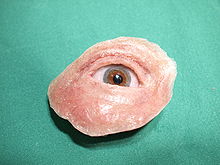Epithesis
The epithesis is used to aesthetically compensate for body defects by means of foreign material such as glass, porcelain, rubber, metal or plastic. The term is derived from the Greek and literally means "the attached".
In contrast to prostheses and orthotics , which mainly replace lost limbs or support their function, the epitheses focus on aesthetic aspects and aspects of social integration.
Areas of application
The main area of application of epitheses is the production of prostheses for the face area, for example, if after accidents, war injuries or tumor operations, a surgical reconstruction with the body's own tissue is not possible or would not produce satisfactory results because complex structures such as the nose, eyelids or the ear are surgically hardly true to nature can be reproduced.
But epitheses can also be used for the aesthetic reconstruction of the female breast or the fingertips if other procedures are not possible or not desired.
history
The first indications of the use of epitheses can already be found in the time of the ancient Egyptians. Pictorial representations are only known from the 16th century . It was also mentioned for the first time in the medical literature during this period. According to drawings by the surgeon Paré , epitheses were made in standard shapes or sizes, and thus in a shape that was hardly adapted to the defect, and tied around the head with threads. Orbit or ear prostheses, on the other hand, were anchored in the cavity using springs.
The beginning of modern epithetics can be dated to the end of the 18th century. The Parisian dentist Nicolas Dubois de Chémant (1753–1824) made obturators , tooth, chin and nose epitheses out of porcelain .
In the years that followed, rubber epitheses were developed that were molded and colored on a plaster model using a multi-layer process . From 1869, the light and easily malleable celluloid and later aluminum were tried out . Gelatine prostheses were then used in 1913, but the patient had to renew them daily using a mold.
PVC and later PMMA as well as silicone were used as materials after 1945. Due to their good shape and support properties as well as their high aesthetics, they almost suddenly replaced all materials known until then.
Modern computer technology has enabled the manufacture of highly refined and miniaturized movable epitheses since the mid-1990s. However, this production method is still the exception.
Fixation and retention of the epithesis
Epitheses either adapt to the body defect through their shape and adhere by themselves, or they are mechanically anchored by metal pins implanted in the bone , which protrude from the skin like small posts. The epithesis is attached to these posts using press studs, bars, clips or magnets.
The choice of fastening elements depends, among other things, on the desired hold and the needs of the patient: For example, young, sporty patients need a more stable epithesis fastening. For older patients, on the other hand, ease of use is often the focus.
An alternative to the implant-supported epithesis is attachment with skin-friendly adhesive . However, this is only suitable for smaller epitheses that do not require great holding force, such as for replacing the tip of the nose. A big advantage is the lower surgical effort, since no implants have to be placed, as well as the simpler hygiene . The disadvantage is the lower hold compared to implant-supported epitheses. In addition, skin irritations and the development of allergies to the adhesive can occur.
Problems
With implant-supported epitheses, the main problem is where the implants penetrate the skin. This must be cleaned and cared for on a regular basis, otherwise inflammation can occur which, in extreme cases, can destroy the surrounding bone and lead to loosening or even loss of the implants. Epitheses can discolour over time (e.g. from cigarette smoke). Silicone prostheses lose their elasticity and become brittle.
Psycho-social aspects
People with facial defects are subject to high levels of suffering. The face and its parts fulfill many functions, but they are particularly important for interpersonal relationships. The face plays a role in making contact, reflects our moods, our character and our previous life and is something like our business card. Many people with facial defects therefore shy away from dealing with other people or even being completely isolated . The consequences are manifold and their full extent is difficult to assess for healthy people. With epitheses, those affected can regain a large part of their quality of life .
costs
The cost of the epithesis and a new production approximately every two years are covered by health insurance companies and private health insurers .
See also
literature
- Alfred Renk: The history of epithetics with special consideration of clinical-practical application as well as the problems of facial prostheses. Berlin 1992.
- Alfred Renk: epithetics, dental. In: Werner E. Gerabek , Bernhard D. Haage, Gundolf Keil , Wolfgang Wegner (eds.): Enzyklopädie Medizingeschichte. De Gruyter, Berlin / New York 2005, ISBN 3-11-015714-4 , p. 362 f.
- Review article. In: Journal of Kiefer-Facial Prosthetics
Web links
- Epithetics - a new face. Südwestrundfunk , April 16, 2015, accessed on January 20, 2017 (TV report in the Odysso series).
Remarks
- ^ Alfred Renk: Ambroise Paré. Founder of facial prosthetics. In: Advances in Medicine. Volume 112, 1994, No. 29, pp. 415-418.
